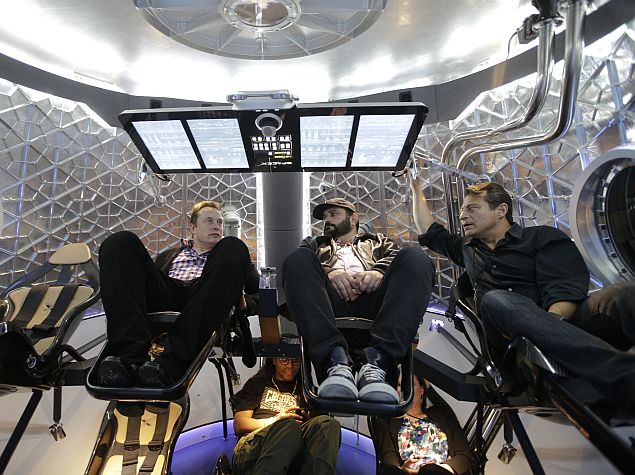- Home
- Science
- Science News
- Nasa Tech for Safe and Precise Spacecraft Landing
Nasa Tech for Safe and Precise Spacecraft Landing

In collaboration with Masten Space Systems in California, engineers at Nasa's Jet Propulsion Laboratory recently tested these technologies on board a high-tech demonstration vehicle called the Autonomous Descent and Ascent Powered-flight Testbed (ADAPT).
ADAPT is a test system built on Masten's "Xombie" vertical-launch, vertical-landing reusable rocket. The Xombie platform provides a good approximation of Mars-like descent conditions through high-speed descent rates at low altitudes.
Those conditions are difficult to achieve through conventional flight test platforms.
Onboard this rocket, two sophisticated lander technologies were recently tested: Terrain Relative Navigation with a sensor called the Lander Vision System (LVS), and the Guidance for Fuel-Optimal Large Diverts (G-FOLD) algorithm.
"No previous Mars lander has used onboard surface imaging to achieve a safe and precise touchdown, but a future spacecraft could use LVS and G-FOLD to first autonomously determine its location and then optimally fly to its intended landing site," said Nikolas Trawny, ADAPT's principal investigator at JPL.
"All of this happens on board, without human intervention, and in real time," said Trawny.
ADAPT technology has numerous potential applications, including landing on the Moon, asteroids and other space targets.
The terrain-relative navigation capability provided by LVS allows Xombie to precisely determine its position without requiring GPS.
To do so, ADAPT first takes a series of pictures of the terrain below it during descent.
These pictures are then compared to an image of the terrain stored onboard, allowing the vehicle to autonomously find its position relative to the landing site.
The spacecraft can then use this information to correct its course to get as close to the targeted landing site as possible within its capability, and make a smooth, pinpoint landing.
G-FOLD is an algorithm, developed at JPL and at the University of Texas at Austin, that calculates the optimal path to divert a spacecraft to a target landing site in real time.
For the first time, G-FOLD allows onboard calculation of divert trajectories that obtain the maximum performance from every kilogramme of propellant.
The combination of LVS and G-FOLD allowed the Xombie rocket to begin to change the course of its descent at about 190 meters in the air.
The rocket then flew the newly calculated course to successfully reach the target landing pad located 300 meters to the east.
Catch the latest from the Consumer Electronics Show on Gadgets 360, at our CES 2026 hub.
Related Stories
- Samsung Galaxy Unpacked 2025
- ChatGPT
- Redmi Note 14 Pro+
- iPhone 16
- Apple Vision Pro
- Oneplus 12
- OnePlus Nord CE 3 Lite 5G
- iPhone 13
- Xiaomi 14 Pro
- Oppo Find N3
- Tecno Spark Go (2023)
- Realme V30
- Best Phones Under 25000
- Samsung Galaxy S24 Series
- Cryptocurrency
- iQoo 12
- Samsung Galaxy S24 Ultra
- Giottus
- Samsung Galaxy Z Flip 5
- Apple 'Scary Fast'
- Housefull 5
- GoPro Hero 12 Black Review
- Invincible Season 2
- JioGlass
- HD Ready TV
- Laptop Under 50000
- Smartwatch Under 10000
- Latest Mobile Phones
- Compare Phones
- OPPO Reno 15 Pro Max
- Honor Win RT
- Honor Win
- Xiaomi 17 Ultra Leica Edition
- Xiaomi 17 Ultra
- Huawei Nova 15
- Huawei Nova 15 Pro
- Huawei Nova 15 Ultra
- Asus ProArt P16
- MacBook Pro 14-inch (M5, 2025)
- OPPO Pad Air 5
- Huawei MatePad 11.5 (2026)
- Xiaomi Watch 5
- Huawei Watch 10th Anniversary Edition
- Acerpure Nitro Z Series 100-inch QLED TV
- Samsung 43 Inch LED Ultra HD (4K) Smart TV (UA43UE81AFULXL)
- Asus ROG Ally
- Nintendo Switch Lite
- Haier 1.6 Ton 5 Star Inverter Split AC (HSU19G-MZAID5BN-INV)
- Haier 1.6 Ton 5 Star Inverter Split AC (HSU19G-MZAIM5BN-INV)

















